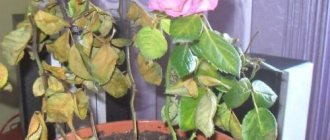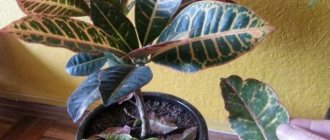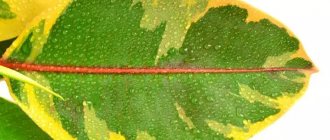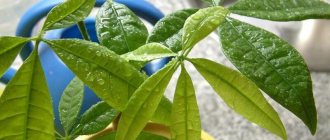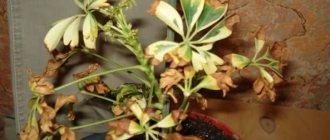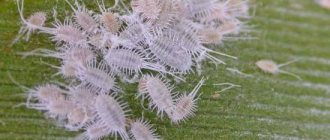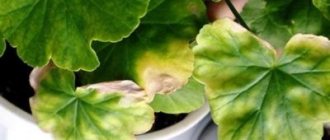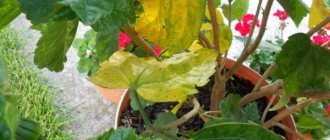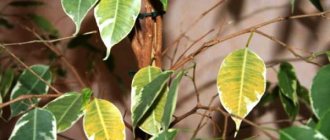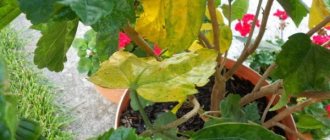On the eve of the New Year and Christmas holidays, many people buy a wonderful plant - poinsettia - to decorate their home. It’s not for nothing that the flower is called the “Christmas star” - it is in December-February that it is most decorative and decorates the apartment with splashes of bright color.
The culture is actually called the most beautiful euphorbia and it is not exactly an indoor flower. In nature, this is an evergreen shrub native to Central America, which reaches a height of 2-3 m, and its red “leaves” are not flower petals at all (the flowers of milkweed are yellow, very small and inconspicuous), but the covering leaves (bracts), which surround. Evolutionarily, plants have developed such an adaptation to attract pollinating insects.
It is precisely because of the large and bright decorative bracts, which are collected in the shape of a conventional “star”, that spurge was introduced into cultivation and received its new name (it was once called the “Mexican fire flower”), and then became a real pre-Christmas seasonal product at first in the USA, and then in the rest of the world.
Each year in the United States, approximately sixty million poinsettias are sold in the six weeks leading up to and during the winter holidays.
Today, cultivated varieties of poinsettia have been developed with other shades of bracts - yellow, pink, white, bicolor, striped, with a contrasting color “spraying” or edging - as well as dwarf forms that feel great at home.
Natural causes
If you create the necessary conditions , it will bloom for a long time, delighting you with its exotic, unique appearance, bright colors of leaves and flowers.
And after flowering, the plant begins a long period of dormancy, during which the leaves drop. This is an absolutely natural process.
If the poinsettia dropped its magnificent leaves in February or early March, then there is no reason to panic .
During this period, you need to cut the bush in half, move it to a cool room, shade it a little, and water it periodically so that the lump of earth always remains moist.
In the wintering place, the temperature should not fall below 10°C. The flower should remain in this state until mid-April, after which it will begin to gradually awaken.
With the onset of the growing season , the poinsettia needs to be transplanted into a new pot, moved closer to bright light and warmth, and active watering and fertilizing begin. Many new young shoots will sprout, but only the strongest of them (3-5 pieces) should be left.
Our article will tell you the secrets of gardeners for caring for bougainvillea at home.
Why auto-watering for indoor plants? Read the answer in our material.
What are the most useful indoor plants - find out about it at the link: https://sad-doma.net/polezno/top/samye-poleznye-komnatnye-rasteniya.html
Diseases
Every plant needs attention. If you forget about the flower, don’t water it, and don’t observe the temperature regime, then it will have no choice but to dry out and die.
What to do if the flower dies?
How to revive a flower if it has completely dried out?
What to do:
- Cut the flower in half.
- Place the pot in a dark and cool room.
- Water once a month.
- Take the plant out after 2-3 months and wait for new shoots.
Frozen
What to do:
- Remove frostbitten shoots.
- Place the flower in a warm room.
- Treat with Zircon, which is a plant biostimulator.
Gray rot
The shoots wither and die.
Due to increased air humidity, mold forms on the darkened stems.
There are light specks on the covering leaves, followed by brown spots. Afterwards the leaf blade dies. A gray coating of sporangia forms on the inflorescences, from which the rotting process spreads to the covering leaves.
What to do: gray rot mainly affects thickened and darkened plantings from August to September.
Chemicals used for processing:
- Fundazol.
- Speed
- Pure flower.
Fungal diseases
Fusarium wilt
The affected shoots inside become brown in color, and then turn black and die. The cause of the disease is fungi of the genus Fusarium.
What to do: remove all affected leaves and shoots, spray the plants with Bactofit. To obtain a solution, you need to dissolve 20 g of powder in 10 liters of water.
Rizop rot
This black-gray rot damages the above-ground parts of the crop. The rotting tissue of the poinsettia is covered with a pale “web”. The cause of the disease is the fungus Botrytis. Increased air humidity can affect its development.
What to do: at the initial stage of infection, you need to use Bordeaux mixture (1 sachet per 10 liters of water), Kuproskat or Topaz.
Late blight
This fungal disease can be recognized by wilting foliage and softening of the roots. The cause is Phytophthora fungi, which spread using zoospores. The infection process can occur through the soil or from one plant to another. The danger of late blight is that it can affect underground and above-ground parts of the crop.
What to do: Only using high-quality soil and a pot will help prevent the development of the disease. If you use homemade soil mixture for planting, it must be sterilized. The following drugs are suitable to combat the disease: Dynamin M45, Syngenta.
Stem rot
This disease forms dark spots on the stem. The leaf blade turns yellow, and the crop itself fades.
Develops at high humidity and temperature. A lack of nitrogen and phosphorus can affect the development of rot.
What to do: spray the affected plants with a solution of copper sulfate or Bordeaux mixture.
Root rot
The disease affects leaves that wither and turn yellow. The root system becomes soft, and the root sheath is separated from the core. Thus, the roots look disheveled. The reason for the spread of fungal spores is high humidity and low acidity of the soil.
What to do:
- reduce indoor air humidity;
- water less often;
- use coarse-grained substrates.
Rust
The leaves have a yellow scorch along the edges. The cause of the development of the disease is high temperature and low humidity.
What to do:
- Spray the leaves with Bordeaux mixture in a timely manner.
- Move the plants to a cool place.
Errors in care
The reasons for dropping leaves may be the following errors :
- unacceptable temperature difference;
- insufficient lighting;
- drying out or waterlogging of the substrate;
- air is too dry.
As you can see, the reasons are the most common. If during the growing season the plant is kept in a bright and warm room, constantly sprayed and fed, there will be no problems. But some gross mistakes can cause not only the loss of leaves, but also the death of the poinsettia .
Most of all, the poinsettia flower is afraid of the cold.
If you leave it in the cold for even a short time, it can be disastrous for the plant: first the leaves will fall off, and then the roots will die. But a short-term drought will not harm the Christmas star.
When the earthen ball dries out , yellowing and shedding of leaves may begin, but it is enough to resume regular watering, and the plant will quickly come into shape.
In addition, the delicate and capricious poinsettia reacts poorly to drafts and excessive dry air, which can also cause disease . But still, most often the culprits of leaf loss are parasitic insects.
How to Care for Poinsettias the Rest of the Year
For the rest of the spring-summer growing season, poinsettia will look like a green bush with soft, erect stems and wide, rounded green leaves - you just need to provide it with proper care, which, however, is not difficult.
Provide the plant with the brightest place in the apartment, but not in direct sunlight - lighting for poinsettia should rather be diffused; it should be shaded from direct sun.
The optimal content temperature is in the range of 16-20°C. At the same time, protect the plant from drafts or constant temperature changes - it really doesn’t like this.
Poinsettias need regular but moderate watering. In summer, water more often, add to the watering by spraying the leaves with warm, settled water. The soil in the pot should never dry out completely, but stagnation of water in the pan is also unacceptable - drain off the excess.
Once every two weeks, provide the plant with complex mineral nutrition (you can use fertilizer for cacti).
If, already during the growing season, your poinsettia's leaves begin to turn yellow or darken, dry out at the edges, droop, wither, curl or fall off, then something has gone wrong. Check for the following traumatic factors, and if so, eliminate them:
- The plant regularly lacks moisture or, on the contrary, it suffers from constant overwatering.
- The plant stands in a draft, is exposed to temperature changes or freezes.
- The plant does not have enough space; it lives in a pot that is too small.
- The plant suffers from dry air.
- The plant has been living in old, depleted soil for a long time, without receiving fertilizing.
- The plant is dark or, on the contrary, is constantly under direct scorching sunlight.
Also regularly inspect your poinsettia for diseases or pests. Gray mold on the leaves, cobwebs, rot or dry dark spots - all these are signs of the “work” of pathogenic organisms; decide on their type and take appropriate measures (fungicides or insecticides).
Pests
Spider mites are tiny red spiders that can form colonies on the undersides of leaves and envelop the plant in white webs. If this pest is detected, you should immediately wash the flower with tobacco tincture and sprinkle with ground sulfur. If these methods do not help, apply insecticides.
Scale insects and mealybugs are no less dangerous for poinsettias. These pests are capable of sucking all the juice out of it in a short time. If you notice powdery plaque or scale insect larvae, remove them mechanically, remove all traces on the leaves and stems, then treat the flower with a soapy solution and rinse with clean water at room temperature.
If the leaves continue to turn yellow and fall off after this, apply fungicides .
Why don't the leaves turn red and fall off?
- The flower partially sheds its greenery. Most likely the plant is frozen or standing in a draft. It is necessary to ensure adequate thermal conditions and eliminate drafts.
- It completely drops its leaves, what should I do? At the end of the growing season, the flower sheds all its leaves. The reason is natural - the flower is going to rest. It is necessary to wait until the leaves have completely fallen and cut the stems in half with scissors, and place the flower in a dark, cool place (the temperature should not be lower than 10°C) for 1.5 months. During the dormant period, moderate watering is carried out. By summer, the poinsettia will again sprout green shoots.
- What if it falls in December? It would seem that December is the time of flowering of the plant and it is illogical to shed its leaves at this time. But there may be reasons for this:
low indoor temperatures;
dry air;
- little light;
- drafts;
- lack of fertilizing.
In this case, it is necessary to find and eliminate the cause. Move the flower to a light windowsill, ensure a comfortable temperature of +17 or +20 °C, and eliminate drafts. From spring until budding, complex mineral fertilizers are applied to the soil once every 2 weeks (liquid flower fertilizers “Agricola” or “Kemira”). During flowering, potassium fertilizers are applied once a month.
What does a poinsettia need?
For normal development and active growth, the Christmas star needs to create conditions close to its natural habitat:
- moderate temperature (from 10 to 16°C in winter and from 17 to 25°C in summer);
- regular moderate watering;
- good lighting during the period of active growth;
- sufficient air humidity.
Why poinsettia leaves turn yellow and fall off and what to do - see the recommendations of professionals in the video below:
Poinsettia , like all beauties, is quite capricious, and its peculiarity is to bloom in the cold season, when most plants rest, making this wonderful plant simply indispensable for the home green collection.
Show a little more care - and it will paint your winter with bright red and green colors and become a real star of the Christmas and New Year holidays.
How to make poinsettia bloom
The peculiarity of growing a Christmas star is that it cannot begin to bloom unless the necessary conditions are created for it first. Starting from October, it is necessary to create a special light regime for the plant.
Every day it is necessary to cover the plant with a box or dark opaque polyethylene for 12-14 hours. In this case, it is worth reducing the temperature slightly (to 17 degrees) and moderating watering. When the poinsettia begins to bloom, you can return to normal.
Fungal diseases
Gray mold
External signs of this disease: gray moldy coating on inflorescences and bracts, discoloration and death of diseased stems and young shoots.
Reason: the fungus Botrytis cinerea actively develops in conditions of high humidity and cold.
Help: carefully select and remove all areas of the plant affected by rot. After this, treat the flower with foundationazole.
Reference! Fundazol is a fungicide with systemic and contact action. As a result of processing, the mushrooms stop reproducing and dividing.
Rizop rot
External signs: the above-ground parts of the plant are affected by black-gray rot. At the same time, the rotting tissues of the flower are covered with a pale “web”.
Reason: the causative agent, the Botrytis fungus, like all fungi, actively develops in conditions of high humidity.
Help: at the first symptoms of the disease, treat with Kuproxat or Topaz.
Reference. Kuproxate is a fungicide whose action is due to the penetration of copper ions into the pathogen cell, interaction with enzymes, inhibiting development, disrupting respiration and protein denaturation. Topaz is a fungicide, active due to penconazole: it suppresses infection at the moment of spore germination and penetration of the fungal growth tube into the leaf tissue.
Southern late blight
External signs: withering of leaves, rotting and softening of plant roots.
Reason: the Phytophthor fungus develops intensively in conditions of stagnant water in the pot.
Help: Ensuring good drainage, regulating watering (rarely, but plentifully). Treat the flower with Allette.
Reference! Allette is a systemic fungicide with protective action. Inhibits and inhibits the germination of fungal spores and blocks the further spread of the disease. Prevents infection from entering the plant.
Infection with fungi of the genus Pythium
External signs: depressed dark spots appear on the flower stem, the roots look frayed and rotten, with a detached shell.
Causes: fungi from the genus Pythium, which develop in conditions of dampness and low acidity of the soil.
Help: temporarily stop watering, replant in dry and loose soil, spray the poinsettia with Ridomil fungicide.
Reference! Ridomil is a fungicide for the prevention and treatment of plants. It is used to combat late blight, alternaria and other fungal diseases.
Brown rot
This disease is typical for young plants.
External signs: the base of the stem becomes thinner, turns brown, and as a result easily breaks and dies.
Cause: fungal infection. The fungus settles on the root collar of the plant and softens it. Grows actively in conditions of high humidity.
Help: treat the stems at the base with Rovral.
Reference! Rovral is a contact fungicide for protecting crops from a range of diseases. Rovral is effective against a wide range of pathogens.
Mold damage to roots
External signs: the roots acquire a brown color and are overgrown with small white roots. Young leaves turn pale, and old leaves turn brown at the edges.
Cause: fungal disease. It develops actively due to a lack of mineral salts.
Help: fertilize with mineral salts. Adjust the watering regime - often, little by little. Spray the plant with Previkur fungicide.
Reference! Previkur is a systemic two-component fungicide. Can be used for watering and spraying. The action is directed against pathogenic flora.
Fusarium wilt
External signs: The shoots of the plant become brown inside, then turn black and die.
Cause: fungi of the genus Fusarium. It penetrates into the plant through wounds or pores of leaves, and in the process of its life activity it produces large quantities of mycotoxins that poison and destroy plants.
Help: free the flower from the affected shoots, treat with Baktofit.
Reference! Baktofit is a biological fungicide whose action is aimed at fungal and bacterial pathogens.
What does a Christmas star flower look like?
The most beautiful poinsettia (poinsettia pulcherrima) is a perennial plant of the Euphorbiaceae family. Wild crop species are found in the tropics of Central America. The indoor poinsettia flower grows up to 50 cm in height. It has an erect stem and a fibrous root system. The dense spherical crown is formed by branched shoots and leaves on long petioles. Being a milkweed, when the above-ground part is damaged, a white, poisonous sap is released.
This is what a Christmas star flower looks like
The ovoid leaves are smooth or serrate with pointed ends. Leaf length is 10-15 cm. The plant blooms from mid-December to March. Yellowish small flowers form at the top of the shoot. They are inconspicuous, collected in a small rosette inflorescence. The plant is made decorative by bright bracts, the rosette of which looks like a star.
More than 100 species of indoor poinsettia have been bred by selection, differing in the color of the bracts, stem height, and size of foliage. The colored leaves on the tops of the shoots are:
- red;
- burgundy;
- white;
- yellow;
- pink;
- spotted;
- with veins, the shade of which differs from the color of the leaf;
- variegated;
- two-color;
- multi-colored.
Types of Christmas trees
Indoor poinsettia has many synonymous names. Some of them are associated with the flowering of culture before the Christmas holiday:
- euphorbia;
- beautiful spurge;
- Christmas tree;
- star of Bethlehem;
- Christmas flower;
- Christmas Day;
- Christmas star.
Why does the flower wither?
Withered, lifeless leaves indicate improper watering: excessive or poor. An optimal watering regime will help restore your poinsettia to its healthy appearance: you need to water it when the soil is almost completely dry.
Important . You should carefully monitor the soil in the poinsettia pot: do not allow it to dry out, especially near the roots.
How to save a plant from pests?
Nematodes
These parasites feed on the sap of the flower. They gather in colonies in the veins and cuttings of platinum leaf. They can be recognized by their discharge, which resembles cotton wool. Infection can occur through:
- Soak a cotton pad in soapy water and wipe the affected leaves.
- Spray the plant with garlic infusion. To do this, grind the head and fill it with water for 8-10 hours. Filter the finished infusion, add 1 bottle of brilliant green and mix. Before use, dilute with water in a ratio of 1:10. If the case is advanced, then spray the plant with an interval of 7 days with Aktara or Fitoverm.
Spider mite
This is a small red beetle that is difficult to notice with the naked eye. It leaves small yellow spots near the tips of the leaves, which indicate that the juice has been sucked out of the plant. Spider mites do not pose any particular danger to the plant. To completely suck the juice out of a poinsettia, you need a large number of pests, and this is unlikely.
What to do: treat the leaf blade with insecticidal soap. To do this, dilute 100 g of soap in 10 liters of water, 1 tbsp. mustard powder and pour in 1 liter of copper sulfate solution.

